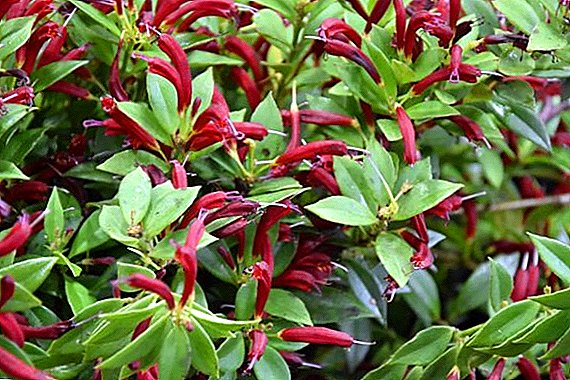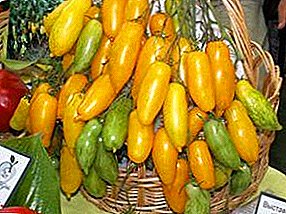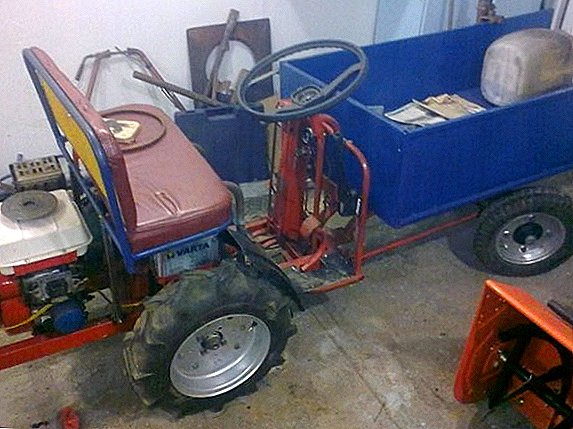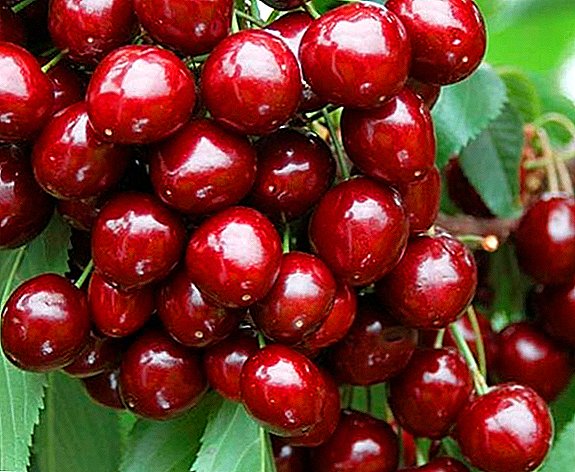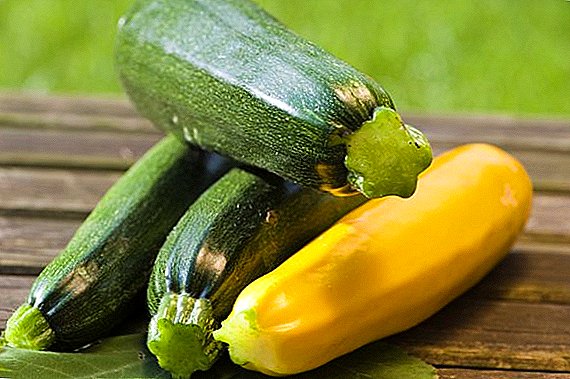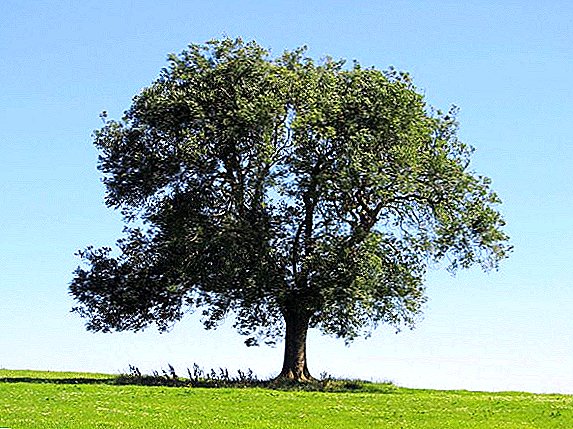 Ash wood was used even by our ancestors to create combat tools and elastic shafts for cold weapons.
Ash wood was used even by our ancestors to create combat tools and elastic shafts for cold weapons.
Currently, the tree is planted as a decorative element of the garden, the fruits of ash are used for food, and the leaves and bark are used for medicine.
Ash: Description
Common ash belongs to the Olive family. This tree, which has a height of up to 30 m, diameter of the trunk - up to 1 m. The crown is highly raised, openwork, the bark is painted gray and covered with numerous "cracks". Ash leaves are colored bright green, lanceolate or oblong-ovate.
Average life expectancy - about 300 years however, few trees live to this age due to diseases and pests.
The fruit of the ash is a "lion" with the seed inside. In nature, a tree propagates both by seed and layering.
Important! Decorative forms of ash multiply only by grafting in order to preserve varietal characteristics.
 Usually, ash blossom from mid-April to the end of May. Flowering begins even before the appearance of leaves, small flowers appear on the branches, which are collected in bunches in the panicles. The flowers are colored dark brown or purple, they can be male, female or bisexual.
Usually, ash blossom from mid-April to the end of May. Flowering begins even before the appearance of leaves, small flowers appear on the branches, which are collected in bunches in the panicles. The flowers are colored dark brown or purple, they can be male, female or bisexual.The widespread use of ash for landscaping cities and parks due to its unpretentiousness and features of the structure of wood. Ash wood is resistant to cracking, flexible, has high strength, therefore, in case of strong storm winds and heavy snowfall, tree branches will withstand the onslaught of bad weather.
Thus, the tree ash according to the description and characteristics is suitable for the role of the main emphasis in the garden. It can be used as a dividing element of the site, or as a "living fence" to protect against noise and dust, if it is planted near the roadway.
What loves ash, where it is best to plant a tree
Having learned about how the ash-tree looks, we proceed to the choice of a place for landing.
Wood is resistant not only to strong gusts of wind, but also to smoke or gas. Therefore, a planted plant near the roadway will not hurt or grow poorly. Ash is very popular in the temperate zone, because can withstand temperatures down to -40 ° C. To make ash feel comfortable, it needs to be planted in a sunny place. He is demanding not only to the light, but also to the fertility of the soil. The tree will not grow on sandy or other marginal soil.
Ash does not tolerate stagnant moisture in the soil or excessive salinity, therefore, for planting, it is necessary to choose weakly acid soils on elevations or places where the ground water is low.
Planting ash
 Now let's talk about how to plant ash. The tree reproduces both generatively and vegetatively. The only difference is that it is much easier to buy an ash tree sapling than to find good germinating seeds.
Now let's talk about how to plant ash. The tree reproduces both generatively and vegetatively. The only difference is that it is much easier to buy an ash tree sapling than to find good germinating seeds.
Features of growing ash from seeds
Last year’s seeds are used for sowing in summer; however, freshly harvested seeds can be planted at the end of August, if the climate allows.
Seeds are sown in the furrows, deepening the planting material by 3-5 cm in the ground. On average, about 8 g of seeds are taken per 1 meter of furrow. If you carry out a large-scale planting, then for sowing 1 hectare at least 240 kg of planting material is used.
The first shoots appear in May. Crops require care, which consists in weeding from weeds, regular watering and minimal loosening of the soil (4-6 times per summer).
Important! In winter, the area under crops is covered with mulch or a special film so that the seeds do not freeze out.According to statistics, about 800 thousand healthy seedlings are received from 1 hectare of crops, which at the age of two are transplanted to another place or allowed for sale.
 Growing ash from seeds requires a lot of time and resources, which is justified only in the case of "large-scale" plantings. If you go to plant 1-2 trees, then it is better to buy a seedling in a nursery or on the market.
Growing ash from seeds requires a lot of time and resources, which is justified only in the case of "large-scale" plantings. If you go to plant 1-2 trees, then it is better to buy a seedling in a nursery or on the market.
The technology of planting ash seedlings
It is much easier to grow an ash tree from a seedling than to plant a seed. To begin, prepare the hole, which should be 1/3 larger than the earthen ball on the rhizome. At the bottom of the pit should be laid drainage (pebbles, expanded clay or fine gravel), which should be 25% of the total height of the pit.
After preparation of the hole, it must be filled with a nutrient mixture, which consists of leafy soil, humus and river sand in the ratio of 1: 2: 1.
Important point: during planting, the rhizome should be 10-15 cm above the ground so that after the soil settles, the root collar does not penetrate the ground.
Before planting, moisten the pit well with water, put supports to which the seedling will be attached.
Important! Ash sapling fixed in the ground strictly vertically, a deviation in any direction will destroy the tree.After immersing the seedling in the hole, fill the empty places with soil mixture and tamp it down.
 We recommend to mix the tree trunk with peat or sawdust in order to preserve moisture in the soil and to protect the sapling from sudden overcooling or overheating of the root system.
We recommend to mix the tree trunk with peat or sawdust in order to preserve moisture in the soil and to protect the sapling from sudden overcooling or overheating of the root system.
When planting several ash seedlings, keep a safe distance that is equal to 5 m for tall trees and 3-3.5 m for dwarf trees.
The nuances of growing ash: how to care for a plant
Knowing where and in what conditions the ash grows, you need to create a similar microclimate in your dacha so that the tree gets everything you need and has a stable immunity to disease.
Watering ash
Ash requires abundant watering, but the amount of moisture you apply to the soil must match the drainage properties of the substrate. That is, if the earth cannot absorb more moisture, then it is not necessary to flood the tree “according to the instructions”.
Ash should be poured only during a severe drought. However, it is worth remembering that Plants can not be watered in a strong wind or in the sun.
Important! If the groundwater lies at a depth of about 1.5-2 m, then the tree itself can get to the necessary moisture using its taproot. In this case, watering is required only in summer and in small quantities.
Options for feeding for ash, how to fertilize the plant
Gardeners are reasonably interested in the question of how to care for ash, so that the tree does not hurt and is not affected by "typical" pests.
 Like a man, a tree has its own immunity, and so that it is strong, The plant needs a variety of fertilizer and fertilizer. Since the nutrient soil mixture that you planted when planting a sapling, is enough for a maximum of 2 years, in the future, the ash must be fed in spring and autumn.
Like a man, a tree has its own immunity, and so that it is strong, The plant needs a variety of fertilizer and fertilizer. Since the nutrient soil mixture that you planted when planting a sapling, is enough for a maximum of 2 years, in the future, the ash must be fed in spring and autumn.
In the spring, 2 kg of manure, 15 g of urea and 25 g of calcium and ammonium nitrate and 20 liters of water are added. That is, we fertilize the tree with nitrogen-containing feedings.
In the autumn, the tree is poured with nitroammophoska (20 g per 20 l of water).
It is worth remembering that, depending on the fertility of the soil, the amount of fertilizer may be more or less. So listen to our advice and use your knowledge.
Did you know? Drugs from ash have hemostatic, tonic, antipyretic, wound healing, laxative, antimicrobial, antispasmodic, antitussive, antirheumatic and anthelmintic action.
What is important to know when pruning ash
 Pruning ash is carried out in the spring, before flowering. Removed dry, frozen and diseased branches. Also, pruning helps to form the crown of the desired shape.
Pruning ash is carried out in the spring, before flowering. Removed dry, frozen and diseased branches. Also, pruning helps to form the crown of the desired shape.
You should start by removing the lower shoots. Shtamb cleared to a height of 3 m.
Then all thin and fragile shoots are removed, which in the future will not be able to withstand the weight of the leaves. It is worth remembering that the tree is prone to growing watery shoots on the lower part of the trunk, which must be immediately removed.
Important! Ash does not tolerate pruning, so do not get carried away with the removal of "unnecessary" shoots. This rule does not apply to dry or diseased branches.Ash is not a capricious tree in terms of planting and care, however, regardless of soil fertility and the height of groundwater, the tree still requires at least minimal attention.
Diseases and pests of ash
Diseases in ash are caused both by improper watering and lack of fertilizing, as well as by strong temperature drops, contamination of the site with rotten remains and insect vectors.
Cytophomic cancer. Fungal disease that affects the bark and sapwood wood. Disease occurs in ash trees aged 10 years or more. The tree suffers from a temperature imbalance, does not tolerate strong heat or frost. With strong cancer lesions, the tree dries out.
Measures to combat the disease: sanitary cutting of diseased trees, enhanced watering of plants.
 Infectious necrosis. Fungal disease, which is characterized by band stripes, the death of the bark and cambium.
Infectious necrosis. Fungal disease, which is characterized by band stripes, the death of the bark and cambium.
Control measures: spring spraying of trees with a 3% solution of ferrous sulfate, spraying during the growing season with a 1% solution of Bordeaux mixture, sanitary and health measures and feeding of trees.
Important! The disease can be transmitted to other trees in the garden.
White finely fissured butt rot. A terrible fungal disease of ash, which affects the central part of the trunk and in some cases the roots. The fungus infects old trees that have gaps or cracks in the bark. At the final stage, ash wood simply falls apart and the tree dries. Identify this disease is almost impossible, because for this you need to cut down a tree.
Control measures: sanitary cuttings, smearing cracks in bark and wood with clay or special protective mixtures.
Did you know? In the 18th century, unripe fruits of ash were preserved in England, getting savory seasoning for vegetable and meat dishes..Now we give a description of some pests that affect the tree ash.
All parasites that harm ash-tree settle in the bark, bast or wood, so it is very difficult to identify them immediately.
A bright ash tree beetle. Dangerous pest of ash trunks and branches. Lube-eater is similar in appearance to the May beetle, grows up to 3 mm, and is colored brown. The beetle appears in late April - early May. It affects the weakened trees or fresh logging. Females lay larvae in the sapwood, which already in June turn into adult individuals. If a tree is badly hit by a bug, then it threatens with inevitable "death." Luboed is so dangerous that it can destroy a large ash planting in a season, turning young trees into eaten dead wood. 
Control measures: insecticide treatment during the beginning of the flight of the beetle ("Ampligo 150", "Enzio 247", "Karate Zeon 050"); attracting birds that feed on bugs (installation of feeders); laying out trap trees in February-March.
Ash-tree emerald narrow goldfish. A beetle insect that is widespread in nature in China, Korea and Japan. Zlatka is painted in marsh green color, has a length of about 1 cm. Females lay eggs on the surface of the bark, after which the larvae penetrate into the bast. You can notice the activity of the larvae after removing the bark: on the surface of the wood, small passages will be visible, along which the larvae move under the bark. Beetles, unlike the larvae, feed not on the bast of the ash tree, but on its leaves, causing serious damage to the tree.
Symptoms of infection: sparse bark, painful tree, premature yellowing of leaves.
Control measures: tampons moistened with hexachlorane suspension (100 g per 1 l of water) are inserted into fresh larvae passages, after which the holes are covered with clay or cement; spraying plantings with 3% chlorophos solution in late May - early June.
 So that the trees do not hurt and are not affected by pests, try to conduct more frequent inspections, cover up the gaps in the bark and bast, and carry out sanitary cutting of sick and dry trees in the garden. Remember that many diseases and pests appear in dirty gardens, where the harvest of plant residues has not been carried out for years. Do not give parasites and diseases an extra chance, and your plants will always look healthy.
So that the trees do not hurt and are not affected by pests, try to conduct more frequent inspections, cover up the gaps in the bark and bast, and carry out sanitary cutting of sick and dry trees in the garden. Remember that many diseases and pests appear in dirty gardens, where the harvest of plant residues has not been carried out for years. Do not give parasites and diseases an extra chance, and your plants will always look healthy.


